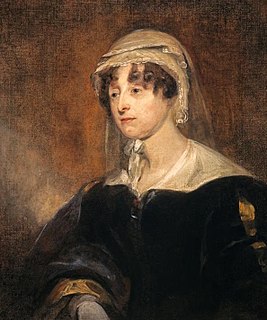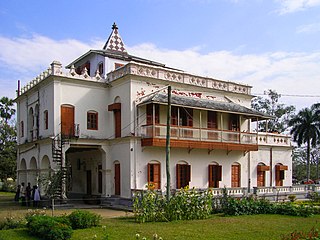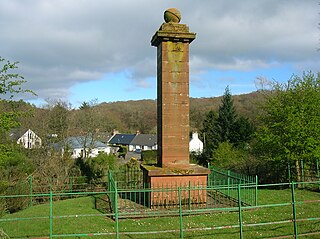Lyrics
| Wikisource has original text related to this article: |
Burns wrote three versions of the song, all published in 1791.
| First Version | Second Version | Third Version |
|---|---|---|
|
|
|
|
|
|
|
| |
|
|
|
|
|
|
|
|
"The Banks O' Doon" (Modern Scots: The Banks o Doon) is a Scots song written by Robert Burns in 1791, [1] sometimes known as "Ye Banks and Braes" (after the opening line of the third version). Burns set the lyrics to an air called The Caledonian Hunt's Delight. [2] Its melodic schema was also used for Phule Phule Dhole Dhole, a song by Bengali poet Rabindranath Tagore. [3]
The song was inspired by the story of Margaret (Peggy) Kennedy (1766—95), who was seduced and then abandoned by Andrew McDouall, the son of a wealthy family and sometime Member of Parliament for Wigtonshire. Kennedy sued for a declarator of marriage, but died prior to adjudication of the case. Although the Consistorial court found the marriage claim valid, the Court of Session decided the marriage claim failed, but found McDouall to be the father of Kennedy's daughter and ordered that he pay £3,000 to Kennedy's estate and provide for the child. [4] [5] (Burns wrote a second poem about Peggy, whom he had met when she was 18 - Young Peggy Blooms. [5] )
The song uses the same tune as the East Anglian variant of the English Folk song "Foggy Dew". [6]
| Wikisource has original text related to this article: |
Burns wrote three versions of the song, all published in 1791.
| First Version | Second Version | Third Version |
|---|---|---|
|
|
|
|
|
|
|
| |
|
|
|
|
|
|
|
|

Bonny Doon is a census-designated place in Santa Cruz County, California. It is situated northwest of the city of Santa Cruz, considered part of the southern San Francisco Bay Area or northern Monterey Bay Area. Bonny Doon's population was 2,678, as reported by the 2010 United States Census.

"Auld Lang Syne" is a Scots-language poem written by Robert Burns in 1788 and set to the tune of a traditional folk song. It is well known in many countries, especially in the English-speaking world, its traditional use being to bid farewell to the old year at the stroke of midnight on New Year's Eve. By extension, it is also sung at funerals, graduations, and as a farewell or ending to other occasions. The international Scouting movement in many countries uses it to close jamborees and other functions.

The Scots Musical Museum was an influential collection of traditional folk music of Scotland published in 1797. While it was not the first collection of Scottish folk songs and music, the six volumes with 100 songs in each collected many pieces, introduced new songs, and brought many of them into the classical music repertoire.

Carolina Oliphant, Lady Nairne – also known as Carolina Baroness Nairn in the peerage of Scotland and Baroness Keith in that of the United Kingdom – was a Scottish songwriter. Many of her songs, such as, "Will ye no' come back again?", "Charlie is my Darling" and "The Rowan Tree" remain popular today, almost two hundred years after they were written. She usually set her words to traditional Scottish folk melodies, but sometimes contributed her own music.
"Foggy Dew" or "Foggy, Foggy Dew" is an English folk song with a strong presence in the South of England and the Southern United States in the nineteenth century. The song describes the outcome of an affair between a weaver and a girl he courted. It is cataloged as Laws No. O03 and Roud Folk Song Index No. 558. It has been recorded by many traditional singers including Harry Cox, and a diverse range of musicians including Benjamin Britten, Burl Ives, A.L. Lloyd and Ye Vagabonds have arranged and recorded popular versions of the song.

Parineeta is a 2005 Indian musical romantic drama film adaptation of the 1914 Bengali novella of the same name by Sarat Chandra Chattopadhyay. Directed by debutant Pradeep Sarkar, it was based upon a screenplay by the film's producer, Vidhu Vinod Chopra. The film featured Vidya Balan, Sanjay Dutt and Saif Ali Khan in the lead roles. Raima Sen plays the supporting role of Lalita's chirpy cousin. Sabyasachi Chakrabarty plays the pivotal role of Shekhar's father. Dia Mirza, with a cameo appearance as Shekhar's fiancé and Rekha, with a cameo performance of a night club singer, are other notable performances.

"Tam o' Shanter" is a narrative poem written by the Scottish poet Robert Burns in 1790, while living in Dumfries. First published in 1791, at 228 lines it is one of Burns' longer poems, and employs a mixture of Scots and English.

The works of Rabindranath Tagore consist of poems, novels, short stories, dramas, paintings, drawings, and music that Bengali poet and Brahmo philosopher Rabindranath Tagore created over his lifetime.
"Annie Laurie" is an old Scottish song based on a poem said to have been written by William Douglas (1682?–1748) of Dumfriesshire, about his romance with Annie Laurie (1682–1764). The words were modified and the tune was added by Alicia Scott in 1834/5. The song is also known as "Maxwelton Braes".
The Bonnie Lass o' Fyvie is a Scottish folk song about a thwarted romance between a soldier and a girl. Like many folk songs, the authorship is unattributed, there is no strict version of the lyrics, and it is often referred to by its opening line "There once was a troop o' Irish dragoons". The song is also known by a variety of other names, the most common of them being "Peggy-O", "Fennario", and "The Maid of Fife".

"The Bonnie Banks o' Loch Lomond", or "Loch Lomond" for short, is a traditional Scottish song first published in 1841 in Vocal Melodies of Scotland. The song prominently features Loch Lomond, the largest Scottish loch, located between the council areas of West Dunbartonshire, Stirling and Argyll and Bute. In Scots, "bonnie" means "pretty", often in reference to a female.

Sings the Songs of Robert Burns is the seventh studio album by Eddi Reader. It was released in the UK on 12 May 2003.

Peacetime is the eighth studio album by Eddi Reader released in the UK on 29 January 2007.
Braes o' Killiecrankie is the name of four distinct folk songs, all originally from Scotland.

A shieling, also spelt sheiling, shealing and sheeling, is a hut, or collection of huts, once common in wild or lonely places in the hills and mountains of Scotland and northern England. The word is also used for a mountain pasture for the grazing of cattle in summer, implying transhumance between there and a valley settlement in winter.
"It isnae me" is a poem by Sally Holmes which was set to music by the English composer Edward Elgar in 1930.

Songs of Scotland is a 1955 album by Jo Stafford. It was released on January 1, 1955 on the Columbia label and features Stafford backed by the Paul Weston Orchestra. The lyrics are all taken from traditional Scottish poetry, many from the work of Robert Burns, with the music written by Alton Rinker.

Robert Burns, also known familiarly as Rabbie Burns, the NationalBard, Bard of Ayrshire and the Ploughman Poet and various other names and epithets, was a Scottish poet and lyricist. He is widely regarded as the national poet of Scotland and is celebrated worldwide. He is the best known of the poets who have written in the Scots language, although much of his writing is in English and a light Scots dialect, accessible to an audience beyond Scotland. He also wrote in standard English, and in these writings his political or civil commentary is often at its bluntest.
Alison Begbie, Ellison Begbie or Elizabeth Gebbie (1762–1823), is said to have been the daughter of a farmer, born in the parish of Galston, and at the time of her courtship by Robert Burns she is thought to have been a servant employed at Carnell House, then known as Cairnhill, on the River Cessnock, situated about 2 miles from Loudoun Mill. It is thought that Burns's youngest sister Isobel Burns confused her name and that she was actually called Elizabeth Gebbie.

Mary Campbell, also known as Highland Mary, was the daughter of Archibald Campbell of Daling, a sailor in a revenue cutter, whose wife was Agnes Campbell of Achnamore or Auchamore Mary was the eldest of a family of four. Robert Burns had an affair with her after he felt that he had been "deserted" by Jean Armour following her move to Paisley in March 1786. The brief affair started in April 1786, and the parting took place on 14 May of that year. Her pronunciation of English was heavily accented with Gaelic and this led to her becoming known as 'Highland Mary.'
In 1882, Tagore would compose, as part of a musical drama, a four-line song which begins with the line Phule Phule Dhole Dhole Bahe Kiba Mridu Bai (Through the Flowers, Down the Slope Blows a Gentle Breeze); this too represents an instantiation of the freedom/constraint schema in which the music of the eighteenth-century Scottish song 'Ye Banks and Braes o' Bonnie Doon' served as the melodic schema.